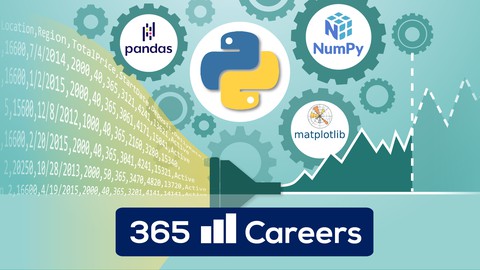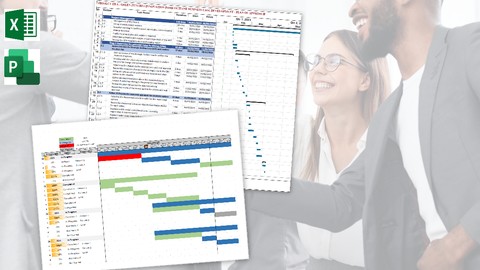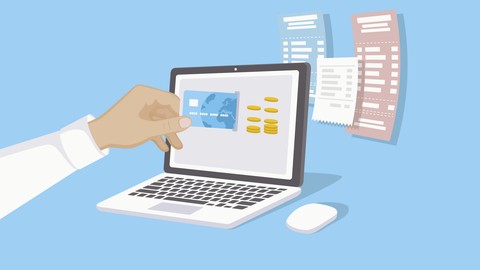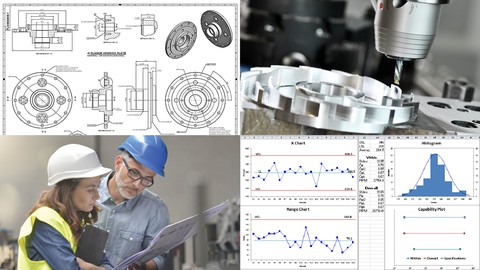The Data Analyst Course: Complete Data Analyst Bootcamp
Loại khoá học: Business Analytics & Intelligence
Complete Data Analyst Training: Python, NumPy, Pandas, Data Collection, Preprocessing, Data Types, Data Visualization
Mô tả
The problem
Most data analyst, data science, and coding courses miss a critical practical step. They don’t teach you how to work with raw data, how to clean, and preprocess it. This creates a sizeable gap between the skills you need on the job and the abilities you have acquired in training. Truth be told, real-world data is messy, so you need to know how to overcome this obstacle to become an independent data professional.
The bootcamps we have seen online and even live classes neglect this aspect and show you how to work with ‘clean’ data. But this isn’t doing you a favour. In reality, it will set you back both when you are applying for jobs, and when you’re on the job.
The solution
Our goal is to provide you with complete preparation. And this course will turn you into a job-ready data analyst. To take you there, we will cover the following fundamental topics extensively.
Theory about the field of data analytics
Basic Python
Advanced Python
NumPy
Pandas
Working with text files
Data collection
Data cleaning
Data preprocessing
Data visualization
Final practical example
Each of these subjects builds on the previous ones. And this is precisely what makes our curriculum so valuable. Everything is shown in the right order and we guarantee that you are not going to get lost along the way, as we have provided all necessary steps in video (not a single one skipped). In other words, we are not going to teach you how to analyse data before you know how to gather and clean it.
So, to prepare you for the entry-level job that leads to a data science position - data analyst - we created The Data Analyst Course.
This is a rather unique training program because it teaches the fundamentals you need on the job. A frequently neglected aspect of vital importance.
Moreover, our focus is to teach topics that flow smoothly and complement each other. The course provides complete preparation for someone who wants to become a data analyst at a fraction of the cost of traditional programs (not to mention the amount of time you will save). We believe that this resource will significantly boost your chances of landing a job, as it will prepare you for practical tasks and concepts that are frequently included in interviews.
The topics we will cover
1. Theory about the field of data analytics
2. Basic Python
3. Advanced Python
4. NumPy
5. Pandas
6. Working with text files
7. Data collection
8. Data cleaning
9. Data preprocessing
10. Data visualization
11. Final practical example
1. Theory about the field of data analytics
Here we will focus on the big picture. But don’t imagine long boring pages with terms you’ll have to check up in a dictionary every minute. Instead, this is where we want to define who a data analyst is, what they do, and how they create value for an organization.
Why learn it?
You need a general understanding to appreciate how every part of the course fits in with the rest of the content. As they say, if you know where you are going, chances are that you will eventually get there. And since data analyst and other data jobs are relatively new and constantly evolving, we want to provide you with a good grasp of the data analyst role specifically. Then, in the following chapters, we will teach you the actual tools you need to become a data analyst.
2. Basic Python
This course is centred around Python. So, we’ll start from the very basics. Don’t be afraid if you do not have prior programming experience.
Why learn it?
You need to learn a programming language to take full advantage of the data-rich world we live in. Unless you are equipped with such a skill, you will always be dependent on other people’s ability to extract and manipulate data, and you want to be independent while doing analysis, right? Also, you don’t necessarily need to learn many programming languages at once. It is enough to be very skilled at just one, and we’ve naturally chosen Python which has established itself as the number one language for data analysis and data science (thanks to its rich libraries and versatility).
3. Advanced Python
We will introduce advanced Python topics such as working with text data and using tools such as list comprehensions and anonymous functions.
Why learn it?
These lessons will turn you into a proficient Python user who is independent on the job. You will be able to use Python’s core strengths to your advantage. So, here it is not just about the topics, it is also about the depth in which we explore the most relevant Python tools.
4. NumPy
NumPy is Python’s fundamental package for scientific computing. It has established itself as the go-to tool when you need to compute mathematical and statical operations.
Why learn it?
A large portion of a data analyst’s work is dedicated to preprocessing datasets. Unquestionably, this involves tons of mathematical and statistical techniques that NumPy is renowned for. In addition, the package introduces multi-dimensional array structures and provides a plethora of built-in functions and methods to use while working with them. In other words, NumPy can be described as a computationally stable state-of-the-art Python instrument that provides flexibility and can take your analysis to the next level.
5. Pandas
The pandas library is one of the most popular Python tools that facilitate data manipulation and analysis. It is very valuable because you can use it to manipulate all sorts of information - numerical tables and time series data, as well as text.
Why learn it?
Pandas is the other main tool an analyst needs to clean and preprocess the data they are working with. Its data manipulation features are second to none in Python because of the diversity and richness it provides in terms of methods and functions. The combined ability to work with both NumPy and pandas is extremely powerful as the two libraries complement each other. You need to be capable to operate with both to produce a complete and consistent analysis independently.
6. Working with text files
Exchanging information with text files is practically how we exchange information today. In this part of the course, we will use the Python, pandas, and NumPy tools learned earlier to give you the essentials you need when importing or saving data.
Why learn it?
In many courses, you are just given a dataset to practice your analytical and programming skills. However, we don’t want to close our eyes to reality, where converting a raw dataset from an external file into a workable Python format can be a massive challenge.
7. Data collection
In the real world, you don’t always have the data readily available for you. In this part of the course, you will learn how to retrieve data from an API.
Why learn it?
You need to know how to source your data, right? To be a well-rounded analyst you must be able to collect data from outside sources. This is rarely a one-click process. This section aims at providing you with all the necessary tools to do that on your own.
8. Data cleaning
The next logical step is to clean your data. This is where you will apply the pandas skills acquired earlier in practice. All lessons throughout the course have a real-world perspective.
Why learn it?
A large part of a data analyst’s job in the real world involves cleaning data and preparing it for the actual analysis. You can’t expect that you’ll deal with flawless data sources, right? So, it will be up to you to overcome this stage and clean your data.
9. Data preprocessing
Even when your dataset is clean and in an understandable shape, it isn’t quite ready to be processed for visualizations and analysis just yet. There is a crucial step in between, and that’s data preprocessing.
Why learn it?
Data preprocessing is where a data analyst can demonstrate how good or great they are at their job. This stage of the work requires the ability to choose the right statistical tool that will improve the quality of your dataset and the knowledge to implement it with advanced pandas and NumPy techniques. Only when you’ve completed this step can you say that your dataset is preprocessed and ready for the next part, which is data visualization.
10. Data visualization
Data visualization is the face of data. Many people look at the data and see nothing. The reason for that is that they are not creating good visualizations. Or even worse – they are creating nice graphs but cannot interpret them accurately.
Why learn it?
This part of the course will teach you how to use your data to produce meaningful insights. At the end of the day, data charts are what conveys the most information in the shortest amount of time. And nothing speaks better than a well crafted and meaningful data visualization.
11. Practical example
The course contains plenty of exercises and practical cases. In the end, we have included a comprehensive practical example that will show you how everything you have learned along the way comes nicely together. This is where you will be able to appreciate how far you have come in your journey to becoming a data analyst and starting your data career.
What you get
A program worth $1,250
Active Q&A support
All the knowledge to become a data analyst
A community of aspiring data analysts
A certificate of completion
Access to frequent future updates
Real-world training
Get ready to become a data analyst from scratch
Why wait? Every day is a missed opportunity.
Click the “Buy Now” button and become a part of our data analyst program today.
Bạn sẽ học được gì
The course provides the complete preparation you need to become a data analyst
Fill up your resume with in-demand data skills: Python programming, NumPy, pandas, data preparation - data collection, data cleaning, data preprocessing, data visualization; data analysis, data analytics
Acquire a big picture understanding of the data analyst role
Learn beginner and advanced Python
Study mathematics for Python
We will teach you NumPy and pandas, basics and advanced
Be able to work with text files
Understand different data types and their memory usage
Learn how to obtain interesting, real-time information from an API with a simple script
Clean data with pandas Series and DataFrames
Complete a data cleaning exercise on absenteeism rate
Expand your knowledge of NumPy – statistics and preprocessing
Go through a complete loan data case study and apply your NumPy skills
Master data visualization
Learn how to create pie, bar, line, area, histogram, scatter, regression, and combo charts
Engage with coding exercises that will prepare you for the job
Practice with real-world data
Solve a final capstone project
Yêu cầu
- No prior experience is required. We will start from the very basics
- You’ll need to install Anaconda. We will show you how to do that step by step
Nội dung khoá học
Viết Bình Luận
Khoá học liên quan

Đăng ký get khoá học Udemy - Unica - Gitiho giá chỉ 50k!
Get khoá học giá rẻ ngay trước khi bị fix.


















Đánh giá của học viên
Bình luận khách hàng